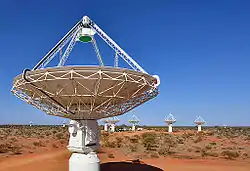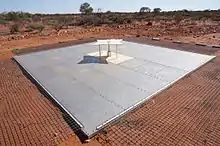Murchison Radio-astronomy Observatory
The Murchison Radio-astronomy Observatory (MRO) was established by CSIRO (Commonwealth Scientific and Industrial Research Organisation) in 2009. It lies in a designated radio quiet zone located near Boolardy Station in the Murchison Shire of Western Australia, about 800 kilometres (500 mi) north of Perth on the traditional lands of the Wajarri people.
 Close up of an ASKAP antenna with several more in the background | |
| Alternative names | MRO |
|---|---|
| Location | Boolardy, Western Australia, AUS |
| Coordinates | 26°42′11″S 116°40′14″E |
| Established | 2009 |
| Telescopes | |
 Location of Murchison Radio-astronomy Observatory | |
| | |
It is one of two core sites for the international Square Kilometre Array (SKA) project, the other being located in South Africa. As part of this project, there have been two technology and science pathfinders, both established by 2012:
- the radio telescopes known as the Murchison Widefield Array (MWA), a low-frequency array operating in the frequency range 80–300 MHz; and
- the Australian Square Kilometre Array Pathfinder (ASKAP).
Construction on the main large SKA telescope started in December 2022. The SKA site has been officially named Inyarrimanha Ilgari Bundara, meaning "sharing sky and stars" in the Wajarri language.
Several smaller experiments (CORE, EDGES, PAPER and SCOPE), unrelated to SKA, are also sited at the MRO.
History
Radio quiet zone (2005)
The MRO was designated a protected radio quiet zone by the Australian Communications and Media Authority in April 2005, and in July 2011, an enhanced radio-quiet zone was imposed. The initial radio-quiet zone (renamed to the "inner zone") was a protected zone in a 70-kilometre (43 mi) radius around the MRO, in which all radio apparatus licences needed to be made with the approval of the MRO governing body. The enhanced radio-quiet zone adds a second zone, effectively extending the license approval governing area from a radius of 70 km to 150 km (93 mi).[1] As of December 2020, the outer "coordination" zone extends for a radius of 260 km (160 mi). Within the radio quiet zone, there are restrictions on all radio communications equipment, including television transmitters, mobile phones, CB radios, and other devices, so as not to interfere with radio telescopes.[2]
As of 2020, the CSIRO and the shire council have been investigating and discussing various internet connectivity possibilities with the shire, such as a small mobile network, or the use of optical fibre.[2]
MRO created (2009)
The CSIRO purchased the 340,000-hectare (840,000-acre) Boolardy Station for A$5.42 million in 2009, then a working cattle station.[2][3][4] The Murchison Radio-Astronomy Observatory was founded by the CSIRO in 2009, near Boolardy, a former cattle station in Western Australia.[5]
By 2012, it comprised the Murchison Widefield Array (MWA) and the Australian Square Kilometre Array Pathfinder (ASKAP).[6]
Land use issues
Indigenous Land Use Agreement
The Commonwealth Scientific and Industrial Research Organisation (CSIRO) and the ASKAP office have been working with the Wajarri Yamatji people to enable the projects to proceed[6] while respecting the cultural needs of the traditional owners of the land, and also to deliver some benefits to them, in particular the tiny and remote Pia Wajarri Aboriginal community, next to Boolardy Station. For several years leading up to 2020, negotiations have been taking place ahead of the signing of an Indigenous land use agreement between the Wajarri people and the CSIRO, guided by the federal Department of Industry, Innovation and Science (now the Department of Industry, Science, Energy and Resources).[2]
About 15 traditional owners are involved in the negotiations, representing different groups within the Wajarri. There are challenges involved in working out how to respect the cultural significance of the area, and how to build the infrastructure with minimal disruption to the landscape. Surveys of heritage sites have been undertaken, but the work and negotiations were somewhat disrupted by the COVID-19 pandemic. The Wajarri people are able to move freely across the land, so long as they respect the radio silence.[2]
Tourism
With the Boolardy Station no longer in use as a cattle station since the owners left the region around 2014,[4][7] the loss of seasonal work in cattle mustering, as well reduced pest control and reduction in community activities has been felt by the people living in the area. The neighbouring Wooleen Station has facilities for guests, and the owners are working with local governments to develop its tourism potential. An interpretive centre situated 100 km (62 mi) from the MRO, at the Murchison Settlement, is one idea under consideration.[2]
Telescopes
Australian SKA Pathfinder (ASKAP)
The Australian Square Kilometre Array Pathfinder (ASKAP) was built by CSIRO and comprises 36 identical antennas, each 12 metres in diameter, working together as a single instrument. ASKAP's combination of fast survey speed and high sensitivity will allow astronomers to answer some fundamental questions about the creation and early evolution of our Universe, and to test theories of cosmic magnetism and predictions from Albert Einstein's general theory of relativity.[8] The facility was formally opened on 5 October 2012.[9]
Murchison Widefield Array (MWA)
The Murchison Widefield Array (MWA) is a joint project between an international consortium of universities to build a low-frequency radio array operating in the frequency range 80–300 MHz.[6] The main scientific goals of the MWA are to detect neutral atomic Hydrogen emission from the cosmological Epoch of Reionization (EoR), to study the Sun, the heliosphere, the Earth's ionosphere, and to study radio transient phenomena. The MWA is the first so-called large-N array, fully cross-correlating signals from 128 phased tiles of 16 crossed dipoles (each). The field of view is large by the standard of astronomical instruments, being on the order of 30 degrees across.
Square Kilometre Array (SKA)
The Square Kilometre Array, commonly referred to as SKA, the SKA Project or SKA Programme, is a radio telescope project undertaken by an international working group, beginning in September 1993.[10] In 2012 it was decided that two sites would be used for the telescopes, one at the Murchison site in Australia[11] and the other in South Africa, while the organisation's headquarters would be located in the UK.[12] The Murchison Widefield Array (MWA) and the Australian SKA Pathfinder (ASKAP) are seen as precursors to the main SKA telescope, with both of these (along with the South African MeerKAT and HERA telescopes) providing useful scientific information while at the same time aiding in assisting the final design, development and testing of the main SKA telescope.[13]
The construction phase of the main telescope at this site began on 5 December 2022, celebrated with a ceremony.[14] The site has been named Inyarrimanha Ilgari Bundara, meaning "sharing sky and stars" in the Wajarri language. This telescope comprises 100,000 antennas built across 74 km (46 mi). Bulldozers are expected to start working on the site in early 2023, with the estimated completion date in 2028.[15]
Experimental projects
Several smaller experiments (CORE, EDGES, PAPER and SCOPE) are being sited at MRO.[16][17]
Experiment to Detect the Global EoR Signature (EDGES)

The Experiment to Detect the Global EoR (Epoch of Reionization) Signature (EDGES) is a radio telescope being developed by MIT Haystack Observatory and Arizona State University (ASU) to make accurate measurements of the sky brightness temperature between 50 MHz and 200 MHz. Its scientific objective is the detection of the global (sky-average) redshifted 21-cm line from Cosmic Dawn and the Epoch of Reionization corresponding to the redshift range 27 6.[18]
See also
References
- "Planning for the radio astronomy service". ACMA. Archived from the original on 9 September 2007. Retrieved 19 June 2012.
- Prendergast, Joanna; Lewis, Chris (7 November 2020). "Why stargazers, modern and ancient, covet a tract of land in Australia's arid heart". ABC News. Australian Broadcasting Corporation. Retrieved 21 December 2020.
- Kruger, Anne (15 May 2011). "15/05/2011: Reach for the stars". ABC Landline. Retrieved 21 December 2020.
- Guilliatt, Richard (11 October 2013). "Life, the universe and Boolardy". The Australian. Retrieved 21 December 2020.
- "Murchison Radio-astronomy Observatory". SKA. Retrieved 19 July 2018.
- "Murchison Radio-astronomy Observatory". CSIRO. Retrieved 21 December 2020.
- Ingram, Tess (24 February 2017). "The Square Kilometre Array: going to infinity and beyond". Australian Financial Review. Retrieved 21 December 2020.
- "ASKAP Science Update, Vol. 1", CSIRO, retrieved 8 November 2010 from http://www.atnf.csiro.au/projects/askap/ASKAP_Science_Update_1.pdf
- "ABC Rural - ABC News". www.abc.net.au.
- "The History of the SKA Project". SKA: Square Kilometre Array (Public Website). Retrieved 22 December 2020.
- "Technology and Science". Australia and New Zealand SKA project. Archived from the original on 30 July 2012. Retrieved 19 June 2012.
- "The Location of the SKA". SKA: Square Kilometre Array (Public Website). Retrieved 22 December 2020.
- "Precursors and pathfinders". SKA: Square Kilometre Array (Public Website). Retrieved 22 December 2020.
- Amos, Jonathan (5 December 2022). "SKA: Construction to begin on world's biggest telescope". BBC News. Retrieved 5 December 2022.
- Clifford, Rachael (5 December 2022). "Square Kilometre Array Telescope construction begins in West Australian outback". ABC News. Australian Broadcasting Corporation. Retrieved 6 December 2022.
- "The Murchison Radio-Astronomy Observatory (MRO)". University of Western Australia. Archived from the original on 3 January 2012. Retrieved 20 June 2012.
- "Operations: Murchison Radio-astronomy Observatory and Geraldton support". International Centre for Radio Astronomy Research. Retrieved 20 June 2012.
- "MIT Haystack Observatory: EDGES". Massachusetts Institute of Technology. Retrieved 20 June 2012.